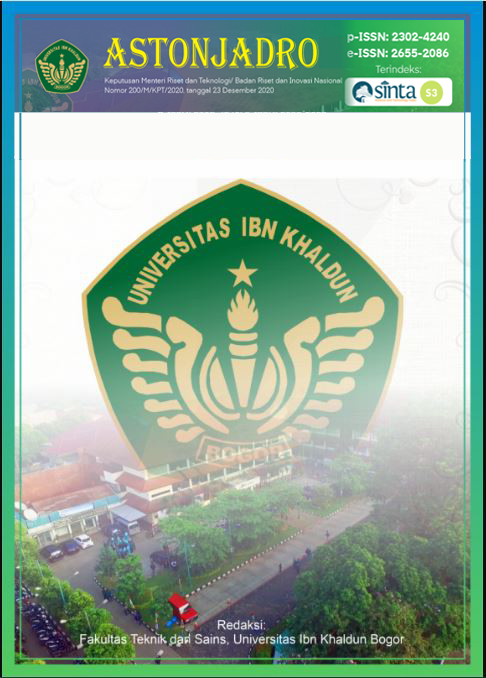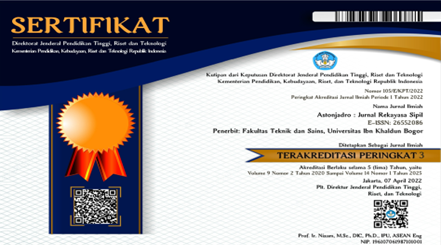The Effects of Implementing Green Roof Scenario on NO2 and Urban Hear Island Distribution in Yogyakarta City
DOI:
https://doi.org/10.32832/astonjadro.v14i1.15982Keywords:
green infrastructure; air quality; urban heat island.Abstract
The development of urban areas requires a city to meet residential space needs which can have an impact on reducing green open space and causing derivative impacts in the form of decreasing air quality. The problem faced by the City of Yogyakarta in developing green open space is limited land, therefore innovation in green open space development is needed, one of which is developing green infrastructure by implementing a green roof scenario. So this research aims to analyze the application of the green roof scenario to air quality, especially in the distribution of Urban Heat Island (UHI) and Nitrogen Dioxide (NO2) in Yogyakarta City. The method used in this research are Landsat 8 images in 2021 with field observations and delineation of the potential area for green roofs at hotels and malls that have rooftops and the potential to implement green roofs. The research results show that implementing the green roof scenario in Yogyakarta can affect air quality. There are changes in the area that decrease the area in UHI class 4 (>3) from 4.74 Ha to 3.78 Ha and an increase in the Non-UHI area from 1,449.68 Ha to 1,731.57 Ha. Based on the NO2 parameter there has also been a change that increases in the area on a very good air quality scale from 406.80 Ha to 560.96 Ha, and a decrease in the area on a very poor scale from 23.71 Ha to 16.24 Ha. The results of the delineation of the UHI map, NO2 distribution, and spatial plans for Yogyakarta City show that locations with high UHI levels and poor NO2 quality are most widely distributed in Kemantren Gondokusuman, Umbulharjo, and Kotagede.
References
Ahmad. F., et, al. 2012. Analisis Hubungan Luas Ruang Terbuka Hijau (RTH) Dan Perubahan Suhu Di Kota Palu. Jurnal Hutan Tropis. Volume 13, No.02, ISSN 1412-4645.
Badan Pusat Statistik Kota Yogyakarta. 2022. Kota Yogyakarta Dalam Angka Tahun 2021. Yogyakarta.
Banirazi Motlagh, S. H., Pons, O., & Hosseini, S. M. A. (2021). Sustainability model to assess the suitability of green roof for urban air pollution reduction applied in Tehran. Building and Environment, 194. https://doi.org/10.1016/j.buildenv.2021.107683
Basuki, A.T. & Saptutyningsih, E. 2012. Pemetaan Polusi Udara Perkotaan dl Propinsi Daerah Istimewa Yogyakarta. UNISIA, Vol. XXXIV No. 76.
Croce, S., & Vettorato, D. (2021). Urban surface uses for climate resilient and sustainable cities: Catalogue of solutions. Sustainable Cities and Society, 75. https://doi.org/10.1016/j.scs.2021.103313
Darmawan, Romi. 2018. Analisis Risiko Kesehatan Lingkungan Kadar NO2 Serta keluhan kesehatan petugas Pemungut Karcis Tol. Jurnal Kesehatan Lingkungan, Vol. 10, No. 1, pp. 116-126.
Dinas Lingkungan Hidup Kota Yogyakarta. 2022. Dokumen Informasi Kinerja Pengelolaan Lingkungan Hidup Daerah Kota Yogyakarta. Yogyakarta.
Dinas Lingkungan Hidup Kota Yogyakarta. 2022. Laporan Analisa Hasil Pemantauan Kualitas Udara Kota Yogyakarta. Yogyakarta.
Duhita, B.P.. Urban Sustainable Cooling Approach To Formulate Spatial Planning Policies In Reducing Urban Heat Island In The City Of Yogyakarta. Tesis, Universitas Gadjah Mada.
Ernawati, R. 2015. Optimalisasi Fungsi Ekologis Ruang Terbuka Hijau Publik di Kota Surabaya. EMARA Indonesian Journal of Architecture. Vol 1 Nomor 2 – Desember 2015. ISSN 2460-7878, e-ISSN 2477-5975.
Fandeli, C., Kaharudin, and Mukhlison. 2004. Perhutanan Kota. Fakultas Kehutanan Universitas Gadjah Mada, Yogyakarta.
Fawzi, N. I. (2017). Mengukur Urban Heat Island Menggunakan Penginderaan Jauh, Kasus Di Kota Yogyakarta. Majalah ilmiah globe, 19(2), 195. https://doi.org/10.24895/mig.2017.19-2.603
Kurnianti, Rindi. 2019. Pengaruh Ketersediaan Ruang Terbuka Hijau Terhadap Urban Heat Island. Tesis, Universitas Gadjah Mada.
Natsir, T. A. dkk. 2018. Simulasi Dampak Pencemaran Udara Karbon Monoksida Di Kota Yogyakarta Akibat Emisi Kendaraan Bermotor (Simulation of Carbon Monoxide Pollution Effect in Yogyakarta City Caused by The Emission of Motor Vehicles). Jurnal Manusia Dan Lingkungan, Vol 24.
Nawangsari, G.M dan Mussadun. 2018. Hubungan Keberadaan Ruang Terbuka Hijau dengan Kualitas Udara di Kota Semarang. 4(1), 11–20. http://ejournal2.undip.ac.id/index.php/ruang/
Rahim, R., et, al. 2016. Karakteristik Data Temperatur Udara dan Kenyamanan Termal Makassar. Prosiding Temu Ilmiah IPLBI. Halaman H 075-078.
Rushayati, S.B., Hadi S. A., Endes. N. D. 2013. Pengembangan Ruang Terbuka Hijau Dengan Pendekatan Kota Hijau Di Kota Kandangan, TATALOKA, vol. 15, no. 4, pp. 306-316, Nov. 2013. https://doi.org/10.14710/tataloka.15.4.306-316.
Tomson, M., Kumar, P., Barwise, Y., Perez, P., Forehead, H., French, K., Morawska, L., & Watts, J. F. (2021). Green infrastructure for air quality improvement in street canyons. In Environment International (Vol. 146). Elsevier Ltd. https://doi.org/10.1016/j.envint.2020.106288
Zahro, H., Sobirin, S., & Wibowo, A. (2018). Variasi spasiotemporal urban heat island di kawasan perkotaan Yogjakarta tahun 2015-2017. Jurnal Geografi Lingkungan Tropik, 2(1). https://doi.org/10.7454/jglitrop.v2i1.35.
Rumiki, E., Axel, J., & Pitaloka, C. P. (2024). Analysis of the Impact of Electric Vehicle Technology on Reducing Greenhouse Gas Emissions. ASTONJADRO, 13(3), 703–707. https://doi.org/10.32832/astonjadro.v13i3.15533
Barri, A. (2024). Application of the Green Building Concept (BGH) in High-Rise Office Buildings Based on Hybrid Dynamics to Improve Cost Performance. ASTONJADRO, 13(3), 870–895. https://doi.org/10.32832/astonjadro.v13i3.15941
Detty Kussumardianadewi, B., Eddy Husin, A., & Septia Prawina, R. (2024). Optimizing Time Performance in Implementing Green Building Concepts on High-Rise Residential by using M-Pert. ASTONJADRO, 13(2), 456–462. https://doi.org/10.32832/astonjadro.v13i2.15059
Downloads
Published
How to Cite
Issue
Section
License
Copyright (c) 2025 ASTONJADRO

This work is licensed under a Creative Commons Attribution-ShareAlike 4.0 International License.
Paper submitted to ASTONJADRO is the sole property of the Astonjadro Journal. Unless the author withdraws the paper because he does not want to be published in this journal. The publication rights are in the journal Astonjadro.ASTONJADRO
LICENSE
This work is licensed under a Creative Commons Attribution-ShareAlike 4.0 International License.
Based on a work at http://ejournal.uika-bogor.ac.id/index.php/ASTONJADRO













